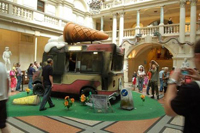 Saatchi vs Banksy for most visited UK show in our annual attendance survey
Saatchi vs Banksy for most visited UK show in our annual attendance survey
While Japan’s love of blockbusters proves recession proof and younger museums top established ones in Paris, London and MoscowPublished online 31 Mar 10 (Museums)
Crowds queued for hours to see Banksy vs Bristol (Photo: www.flickr.com/waltjabsco)
London. When Charles Saatchi fell out with the landlords of London’s County Hall in 2005—a dispute that ended in court—the collector took the setback in his stride. He opened the new Saatchi Gallery on the King’s Road in Chelsea in October 2008, hoping that it would attract “well over one million visitors” a year. The Art Newspaper’s 15th annual survey of attendance figures confirms that Saatchi has hit that target, tempting 1.2 million to visit. “The Revolution Continues: New Art from China” exhibition and “Unveiled: New Art from the Middle East” attracted 4,139 and 3,828 people a day respectively, tallied by automatic counter. This made them the first and third most visited shows in the UK. Only the “Banksy effect” stopped Saatchi securing a top one and two in the UK. The street artist/local boy made good drew almost 4,000 people a day to see his interventions, or “remix”, of Bristol’s City Museum and Art Gallery.
As in London, in Paris and Moscow young museums have toppled long-established ones from the top of the exhibition tree in each respective city. But globally Japan’s museums remain in a league of their own when it comes to organising blockbuster exhibitions.
Three Tokyo museums and one in Nara, 300 miles south west of the capital, fill the top four places. As in 2008, the average visitor-per-day statistics from Japan are staggering. When the Tokyo National Museum displayed Ashura, one of the nation’s most famous Buddhist statues, along with other treasures from the Kohfukuji temple, Nara, on average 15,960 people a day went to see them. In Nara itself, the capital of Japan in the eighth century, almost the same number of people went daily to see Shoso-in treasures, which included objects belonging to Emperor Shomu (701-756), at the Nara National Museum. When the Tokyo National Museum borrowed treasures from the Imperial Collection to mark the 20th anniversary of the coronation of Emperor Akihito, it attracted a “mere” 9,473 visitors a day.
The huge crowds flocking to see Japan’s spiritual treasures has a spiritual as well as artistic dimension—with some people praying in front of the objects in the museums. This phenomenon was the subject of a symposium at the Tokyo National Museum last month. Greg Irvine, the senior curator in the Japanese department of the Victoria and Albert Museum, London, who attended the symposium and the Ashura exhibition, says the popularity of such shows is increasing, and it mirrors the popularity of open days in the temples. “The negotiations involved in getting [such treasures] to the museum are endless,” he says.
There is a museum new to the blockbuster list in fifth place: the Musée Quai Branly in Paris. The ethnographic museum attracted an average of 7,868 visitors a day to the second edition of its Photoquai Biennale, a celebration of international photography, just ahead of “Picasso and the Masters” at the Grand Palais. A third show in Paris, the Pompidou’s “Kandinsky”, proved almost as popular, which put the venue in seventh place, a rise of 30 places on its Giacometti show in 2008.
In terms of strength in depth from one institution, New York’s Museum of Modern Art (MoMA) is unrivalled. In 2009 its exhibitions provided seven of the top 16 shows. Joan Miró attracted 6,299 visitors a day, and Pipilotti Rist’s “Pour Your Body Out (7345 Cubic Meters)”, a sensuous multi-media makeover of its otherwise chilly atrium, attracted almost the same number of visitors. “Van Gogh and the Colours of the Night” attracted more than 436,000 visitors in total, but when the average visitor per day is calculated, the show comes after James Ensor, Ron Arad, Martin Kippenberger and Marlene Dumas exhibitions. This may be reflection of the effectiveness of MoMA’s timed-entry ticketing for Van Gogh, however. Staying in the US, the Metropolitan Museum of Art’s “Vermeer’s Masterpiece The Milkmaid”, the latter on loan from the Rijksmuseum, Amsterdam, came next after MoMA’s best seven.
In Moscow, the new Garage Centre for Contemporary Art was the most visited venue in the Russian capital, attracting three times the number of visitors per day to the Moscow Biennial than the Tretyakov did with a thematic exhibition of flowers in Russian art.
As large-scale exhibitions can take several years to prepare, the effects of the financial recession—and the scarcity of business sponsorship to mount them—will begin to become apparent in next year’s list. The silver lining for many museums during a tough 2009 funding wise has been that total attendance figures have generally held firm or dipped only slightly.
At the top of the annual museum attendance list for 2009, the world’s great encyclopaedic museums, the Louvre, British Museum and the Metropolitan Museum of Art, stand proud as in previous years. Institutions that have unveiled new wings include the Museo del Prado and the Art Institute of Chicago. The Prado’s new entrance, which opened in April 2007, greatly increased visitors’ comfort and convenience more than numbers last year, accommodating an extra 4,100 people. But the Modern Wing of the Art Institute of Chicago, which opened its doors in May last year, helped boost the US art museum’s attendance by almost 450,000. The Reina Sofía in Madrid also did well, breaking the two million mark last year.
Figures compiled by Emily Sharpe and Helen Stoilas with Rob Curran, Megan Empey, Alessandra Franzi, James Hobbs and Josephine von Perfall
 Saatchi vs Banksy for most visited UK show in our annual attendance survey
Saatchi vs Banksy for most visited UK show in our annual attendance survey